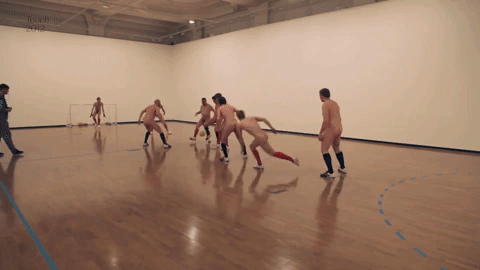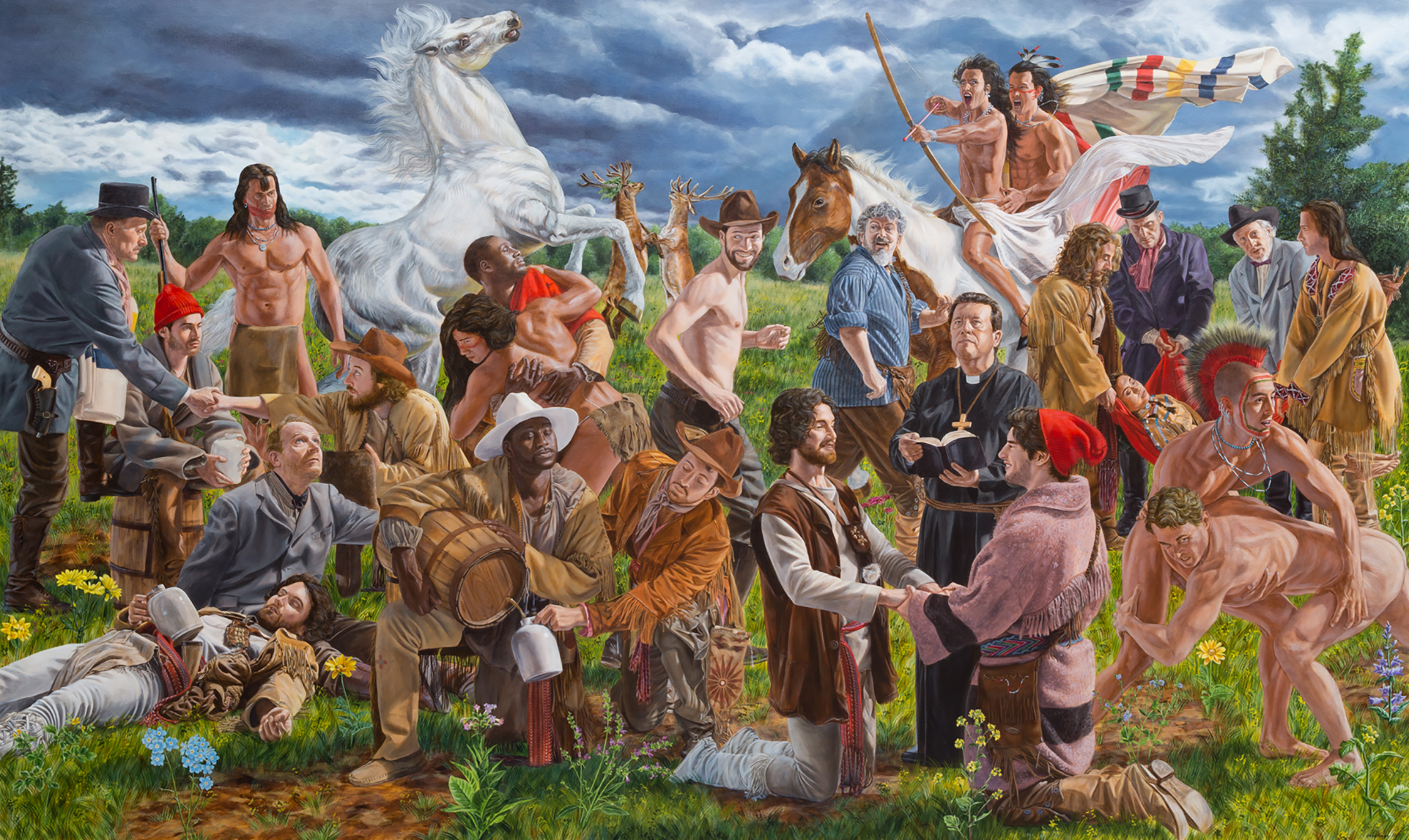Eddie Peake is Exploring Impulse

British multidisciplinary artist Eddie Peake is exploring impulse through nudity, sexuality, and athleticism.
Cover photo: Come Over Everything, lacquered spray paint on polished stainless steel, by Eddie Peake (2013). Via White Cube.
This article is part of my 30 Living Queer Artists Worth Celebrating in 2019 series. June is Pride Month, commemorating the international gay rights movement that began June 28th, 1969, with the Stonewall riots of New York. 2019 marks the 50th anniversary of the event. I’m celebrating all month long!
WARNING: The following article features and/or discusses graphic nudity, pornography, homoerotica, and sex.
Eddie Peake
Eddie Peake’s artwork is explicit, often exploring nudity, sexuality, and athleticism. He explains, “I want to make work according to my real-life impulses and feelings. As it so happens, that results in an erotic and ambiguous kind of sexuality, which is how I see my own sexuality today.”
An explicit photo, a nude performance, an illustrative screenprint, a cheeky sculpture… Peake creates work in any medium that comes to mind. Still, Peake says, “I envy artists who do one thing – and there are lots of artists who do that in a brilliant way. Let’s say there’s a painter and he comes in to the studio every day and makes paintings of cars. So what does he do with any ideas that do not pertain to that? What does he do when he thinks, wouldn’t it be wicked to see a sculpture of a fawn riding a sheep going yeehaw and waving a lasso around his head? I’ve got no choice but to do it.”
Much of Peake’s work is tied to this idea of impulse. “I’m a ferocious attention seeker but absolutely crippled with shyness and insecurity at the same time,” Peake admits.
Nudity and Sport
Peake is best known for his 2012 performance piece Touch, a five-on-five 30-minute football (soccer) match in which male players were only clad in shoes and socks denoting their team. Peake created the piece while still a student at London’s Royal Academy.
Peake considers the body a medium like any other artform. “It’s one of the mediums I’m interested in working with. Like acrylic, like neon, like stainless steel,” he says. “I like to depict the body in a way that occupies an ambiguous aesthetic space that transcends or toys with categories of things like gender and sexuality.”
Touch is a uniquely fascinating performance. The work draws upon notions of exhibitionism and voyeurism within the mundane, but certainly physical, act of sport. The sheer name of the event, Touch, has a homoerotic connotation, though, Peake seems to ask, “is there anything inherently sexual about naked men, with flaccid genitals, kicking a ball around a court?”
In 2015, Peake restaged his Touch performance at the art gallery Palais de Tokyo under the title Duro, an Italian word translating to “hard on.” However, Peake explains that he doesn’t intend to shock the audience, “In Duro, nudity comes to seem natural and uninhibited, but of course in our society it generally isn’t. This is something I'm interested in examining — or rather asking the viewer to examine. I like people visiting my exhibitions or performances to have active experience of viewing. Confronted with nudity, I imagine people start to think about their own reactions — whether they are a bit embarrassed, awkward, even turned on, or feel like a voyeur, and why. In turn they might become really conscious of being physically present and engaged with the work. That’s not the same as just wanting to shock, provoke or titillate though.”
There’s a long tradition of nudity in sport. The English word “gymnasium” is derived from the Greek “gymnos” meaning “naked”, as ancient athletes exercised in the nude. Plato describes the gymnasium as a place where men would search for youths to mentor and have sex with. Women were, of course, forbidden.
Since then, sport has become a heterosexual — though still homoerotic — spectacle. On the field, male athletes feel comfortable to cry, hug, and slap each other on the behind. As American artist Barbara Kruger once noted, “[men] construct intricate rituals which allow [them] to touch the skin of other men.”
In the context of the art world, nudity is usually confined to stillness in sculpture, paintings, or photography. Peake adds in a separate interview, “It’s quite odd because I lived in Rome for a couple of years, and everywhere you turn there is a naked sculpture, and yet, if you want to employ nudity… I feel like we live in this weird age of conservatism in which people are desperate to find opportunities to be offended. So desperate are they in fact that they’ll even be offended by things which aren’t actually offensive.”
Athletic Sensuality
Of course, Peake is unashamed about relating athleticism to eroticism. In 2016, Peake was invited to create a limited edition print in relation with the Rio Summer Olympics. In keeping with the rest of his oeuvre, Peake focused on the sensuality of the games. The print reads, “Jolting body [with] sweaty skin. A sheen of sweat, iridescent in twilight.” The text overlay sits on a gradient of acidic colors, an allusion to raves (another display of physicality).
About the erotic theme, Peake admits, “I guess it’s because it’s an aspect of the Olympic Games that’s not often talked about, but one I think is a totally legitimate reason to enjoy them as a viewer. I’d use that description for sports in general, not just the Olympics.”
Sexuality
The categories of “homosexuality” and “heterosexuality” (with which we have now become so saturated) only first appeared in the West at the end of the 19th century. In Ancient Greece, for instance, no one identified as having same-sex or opposite-sex attraction. The idea of “active” or “passive” was used to describe the role a participant performed, rather than gender or sexual identity (similar to “top” or “bottom” today).
The Baddest Badman
Peake has developed an alter-ego, a faun inspired by the “hyper-sexualised, uber-masculine, quite mischievous and naughty” ancient Greek god Pan. Pan was a fertility deity associated with vigor and lust.
The first work of Peake’s featuring the faun is his neon sculpture The Baddest Badman in 2013. Of course, today the anthropomorphic Pan wields the implication of a fursona, from the furry subculture in which fans dress in animal-inspired costumes. Peake has also created a series of acrylic bears, an animal that carries significance in the gay community. Peake has not addressed these connections (as far as I’ve found).
Depression
Peake has also struggled with depression, which has impacted both his identity and his art. He has spent time in psychiatric hospitals and tried a variety of medications. Peake wonders, “if you ask someone who is struggling with psychiatric issues, how can that not impact on your sense of self in the world?”
“My feeling is that if depression is at the core of your existence, your job is to try to get other experiences and feelings to kind of cover it up, and the everyday trials and tribulations of just being a person might embolden those other layers or they might strip them away,” Peake notes. Perhaps this explains the heightened sense of euphoria and joie-de-vivre in his work.
Transition
Currently, Eddie Peake appears to be in a state of transition regarding his art but he promises to continue to “obfuscate and discombobulate the way we see the world.” Follow Peake on Instagram!

















